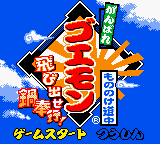Retro Replay Review
Gameplay
Ganbare Goemon: Mononoke Dōchū Tobidase Nabe-Bugyō! takes the series’ classic RPG formula and injects it with a monster-dueling twist that will feel familiar to fans of turn-based duels. Players traverse a colorful overhead map of feudal Japan, delving into villages, forests, and castles to pick up quests, uncover hidden items, and advance the main storyline. Exploration is steady and well-paced, with each new locale presenting a fresh batch of puzzles or side quests that reward keen-eyed adventurers.
(HEY YOU!! We hope you enjoy! We try not to run ads. So basically, this is a very expensive hobby running this site. Please consider joining us for updates, forums, and more. Network w/ us to make some cash or friends while retro gaming, and you can win some free retro games for posting. Okay, carry on 👍)
Combat departs from the usual full-party tangle, instead pitting your trained monsters one-on-one against foes in quick, strategic duels. As you defeat enemy creatures, you can capture them and add them to your roster, giving you a stable of monsters to level up, evolve, or even merge to unlock powerful new skills. This system adds a surprising layer of depth, encouraging experimentation with different monster combinations to exploit elemental affinities and special attacks.
One of the most enticing features is the ability to link up with the N64’s Mononoke Sugoroku, letting you trade creatures between the two titles. This cross-game connectivity not only boosts replay value but also fosters a collectible aspect that echoes the “gotta-catch-’em-all” sensibility without feeling derivative. Overall, the gameplay loop strikes a satisfying balance between story-driven quests, monster management, and strategic dueling.
Graphics
On the visual front, Mononoke Dōchū Tobidase Nabe-Bugyō! employs a vibrant, cartoonish aesthetic that perfectly captures the playful spirit of the Goemon series. Character sprites are richly detailed, from Goemon’s mischievous grin to the wide-eyed monsters that range from adorable to downright grotesque. The color palette pops on screen, creating a lively atmosphere that turns every village and dungeon into a memorable stage.
Backgrounds and environmental art strike a strong balance between traditional Japanese motifs—temple rooftops, bamboo groves, misty mountains—and whimsical touches like floating lanterns or oversized cooking pots. Enemies and NPCs animate smoothly, with each monster boasting a unique idle pose or attack animation that adds charm during battles. Even on older hardware, the framerate holds steady, ensuring that combat feels snappy and exploration remains uninterrupted.
Special effects, such as elemental spells or monster fusion sequences, are accompanied by playful flourishes—sparkles, smoke rings, or swirling kanji characters—that heighten the sense of impact without overwhelming the screen. While the game doesn’t push the console to its limits, its consistent art direction and attention to small details make for a visually appealing journey through a fantastical Edo period.
Story
The narrative kicks off when an evil warlord seizes Edo Castle and unleashes hordes of bizarre demons across Japan. It falls to Goemon and his trusty companions to restore peace, battling through haunted shrines, bustling towns, and demon-infested strongholds. The plot weaves traditional folklore references with slapstick humor, ensuring that the tone stays light even when the stakes feel high.
Interactions between Goemon, Ebisumaru, and the supporting cast are a highlight, peppered with witty one-liners and cultural in-jokes that reward longtime fans. Each major quest unfolds with charming cutscenes and dialogue sequences that establish clear motivations for both heroes and villains. Side characters—ranging from frantic villagers to eccentric monk guides—offer comedic respite and often present optional challenges or mini-stories that deepen the world.
Despite its whimsical veneer, the story features moments of genuine intrigue, especially when confronting the masterminds behind the demon floods. Players who appreciate lighthearted storytelling with occasional emotional payoffs will find the narrative engaging from start to finish. The pacing generally keeps momentum high, with just enough downtime between boss battles to explore or train new monsters.
Overall Experience
Ganbare Goemon: Mononoke Dōchū Tobidase Nabe-Bugyō! offers a unique hybrid of classic RPG exploration and one-on-one monster dueling that feels fresh within the long-running franchise. Its accessible mechanics, coupled with the deeper fusion and training system, make it equally appealing to newcomers and series veterans. The ability to trade monsters with Mononoke Sugoroku extends the game’s life substantially, adding a collector’s element that hardcore fans will adore.
While some players may miss the full-party battles of previous Goemon RPGs, the streamlined combat here is quick to learn yet difficult to master. The humor and art style retain the series’ trademark charm, and the varied environments prevent exploration from ever feeling repetitive. A handful of fetch quests can slow the pace at times, but the lure of discovering new monsters and upgrading your roster keeps progression engaging throughout.
For anyone seeking a quirky, lighthearted adventure set against a vividly realized feudal Japan, with the added thrill of Pokémon-style monster duels, this title is a strong recommendation. It captures the best of both worlds: the endearing zaniness of Ganbare Goemon and the addictive draw of collectible creature mechanics, all wrapped in a polished, well-crafted package. Whether you’re a longtime Goemon aficionado or simply looking for an offbeat RPG experience, Mononoke Dōchū Tobidase Nabe-Bugyō! delivers on multiple fronts.
 Retro Replay Retro Replay gaming reviews, news, emulation, geek stuff and more!
Retro Replay Retro Replay gaming reviews, news, emulation, geek stuff and more!




Reviews
There are no reviews yet.